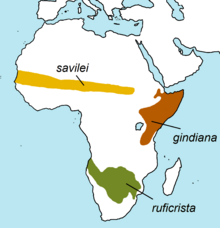
Bustards, including floricans and korhaans, are large, terrestrial birds living mainly in dry grassland areas and on the steppes of the Old World. They range in length from 40 to 150 cm. They make up the family Otididae. Bustards are omnivorous and opportunistic, eating leaves, buds, seeds, fruit, small vertebrates, and invertebrates. There are 26 species currently recognised.
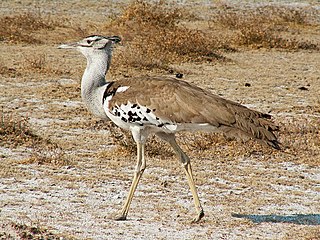
The kori bustard is the largest flying bird native to Africa. It is a member of the bustard family, which all belong to the order Otidiformes and are restricted in distribution to the Old World. It is one of the four species in the large-bodied genus Ardeotis. In fact, the male kori bustard may be the heaviest living animal capable of flight.

The great Indian bustard or Indian bustard, is a bustard found on the Indian subcontinent. A large bird with a horizontal body and long bare legs, giving it an ostrich like appearance, this bird is among the heaviest of the flying birds. Once common on the dry plains of the Indian subcontinent, as few as 150 individuals were estimated to survive in 2018 and the species is critically endangered by hunting and loss of its habitat, which consists of large expanses of dry grassland and scrub. These birds are often found associated in the same habitat as blackbuck. It is protected under Wildlife Protection Act 1972 of India.

The lesser florican, also known as the likh or kharmore, is the smallest in the bustard family and the only member of the genus Sypheotides. It is endemic to the Indian Subcontinent where it is found in tall grasslands and is best known for the leaping breeding displays made by the males during the monsoon season. The male has a contrasting black and white breeding plumage and distinctive elongated head feathers that extend behind the neck. These bustards are found mainly in northwestern and central India during the summer but are found more widely distributed across India in winter. The species is highly endangered and has been extirpated in some parts of its range such as Pakistan. It is threatened both by hunting and habitat degradation. The only similar species is the Bengal florican which is larger and lacks the white throat, collar and elongated plumes.

Denham's bustard, Stanley bustard or Stanley's bustard is a large bird in the bustard family. It breeds in much of Sub-Saharan Africa. It is a species of open ground, including agricultural land, grassland, flood-plains and burnt fynbos. It is resident, but some inland populations move to lower altitudes in winter. The common names for this species refer to the English explorer, Major Dixon Denham, and the English naturalist Edward Smith-Stanley, 13th Earl of Derby.
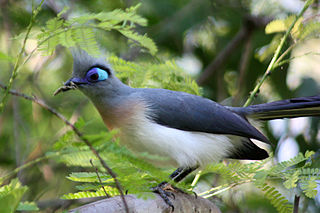
The crested coua is a common medium sized bird member of the cuckoo family, Cuculidae. It is endemic to Madagascar, mainly found in the coastal regions of the island. The crested coua is a weak flyer, so it will often be observed hopping from branch to branch in high canopies. It is distinguished mainly by its greenish-grey back, its prominent grey head crest, rufous-coloured breast, white abdomen and bright turquoise and blue patches of bare skin around the eyes.

The southern black korhaan, also known as the black bustard, is a species of bird in the bustard family, Otididae. This small bustard is found in southwestern South Africa, from Namaqualand, south to Cape Town and east to Makhanda. It prefers semi-arid habitats such as grasslands, shrublands and savannas where it can easily prey on ground-dwelling arthropods and eat seeds. It reproduces yearly in the spring and will lay about one or two eggs per breeding season.

Eupodotis is a genus of bird in the bustard family Otididae. It contains the five species, all restricted to Africa. Species in the genera Afrotis and Lophotis are sometimes included in this genus; however some authorities separate the Karoo korhaan, Rüpell's Korhaan and little brown bustard as a separate genus Heterotetrax.

The northern black korhaan, also known as the white-quilled bustard, is a species of bird in the bustard family, Otididae. It is widely distributed across Southern Africa. Its habitat is primarily open grassland and scrub.

The blue korhaan or blue bustard is a species of bird in the family Otididae which is native to South Africa. Its call is a series of frog-like croaks, usually uttered in flight. Its natural habitat is plateau grassland, dry shrubland, arable land and pastureland. Its preferred habitat is one with short grassland and flat topography.
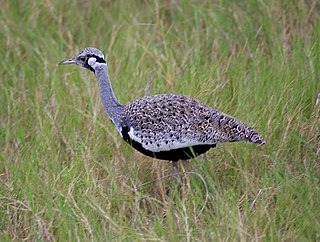
Hartlaub's bustard is a species of bird in the family Otididae. It is found in open grassland with grass up to 1800 meters in Ethiopia, Kenya, Somalia, Sudan, Tanzania, and Uganda.
The little brown bustard is a species of bird in the family Otididae. Found in Ethiopia and Somalia, its natural habitats are subtropical or tropical dry shrubland and subtropical or tropical dry lowland grassland. As indicated by its name, this bustard is the world's smallest at 45 cm (18 in) and 600 grams (1.3 lb). It is threatened by habitat destruction.

The black-bellied bustard, also known as the black-bellied korhaan, is an African ground-dwelling bird in the bustard family.
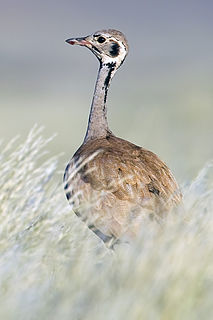
Rüppell's Korhaan, also known as Rüppell's bustard, is a species of bird in the family Otididae. The species is a small bustard, only 60 cm long. The head and neck are grey, with black stripes down the throat, through the eye, and on the sides of the neck, and white cheeks. The body is sandy brown above, and white below. The legs are sandy yellow-brown. Rüppell's Korhaan received its name to recognize Wilhelm Rüppell, a German explorer, collector and naturalist. It is native to southwestern Africa in Angola and Namibia, Collar, N. J. "The bustards and their conservation." Bustard in Decline, Jaipur (1982): 244–255. It is one of Namibia's 13 native birds found in the western part of the country. On overage they inhabit areas with low rainfall such as deserts, plains, and savannahs. Where their exceptionally senses play a major role in their security. It is most likely found in Namibrand nature reserve, Mirabib, Ganab in the Namib-Naukluft Park, Bloedkoppie, and in the Spitzkoppe surroundings.
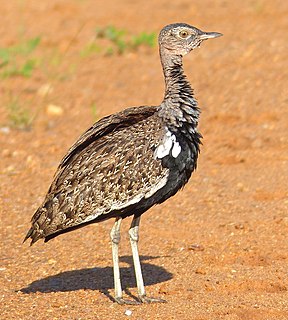
The red-crested korhaan or red-crested bustard is a species of bird in the family Otididae. It is found in Angola, Botswana, Mozambique, Namibia, South Africa, Swaziland, Zambia, and Zimbabwe.
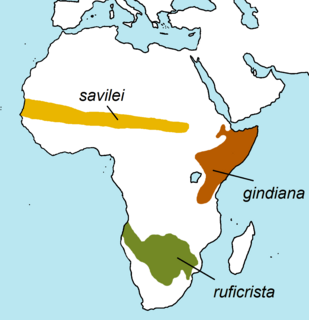
Savile's bustard is a species of bird in the family Otididae. Otididae are an Old-World and understudied family of birds mostly found in Afro-Tropical regions. It is found in Burkina Faso, Cameroon, Chad, Ivory Coast, Gambia, Mali, Mauritania, Niger, Nigeria, Senegal, and Sudan.

The white-bellied bustard or white-bellied korhaan is an African species of bustard. It is widespread in sub-Saharan Africa in grassland and open woodland habitats.

The karoo korhaan, also known as karoo bustard, is a species of bird in the bustard family, Otididae, from Southern Africa. The species is sometimes placed in the genus Heterotetrax. It is the sister-species to Rüppell's korhaan, and the two species are sometimes considered conspecific. There are two subspecies, the nominate race, from south-eastern South Africa, and E. v. namaqua, from north-eastern South Africa and southern Namibia.

Ludwig's bustard is a species of bird in the bustard family, and named after Baron von Ludwig. It is a medium-to-large sized species.

Lophotis is a genus of bustard in the family Otididae. The genus contains three species, all found in Africa. All three species are sometimes placed in the genus Eupodotis, and are closely related to that genus and the genus Afrotis. One distinctive feature of the genus is a pink retractile crest.

